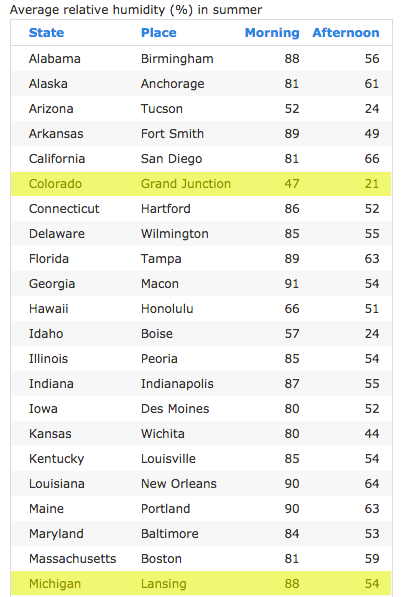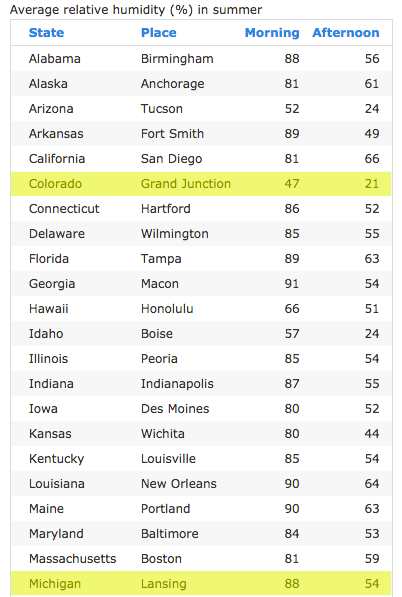transition wild
Off

Although I am completely new to Colorado and have yet to set foot in the mountains to pursue Colorado mule deer or elk, my daily activities have already offered some insight as to what lies ahead for when I actually do engage in the pursuit. I have already noticed major differences in day to day activities that no one told me about before I made the move to the mountains! Ok, some of them I knew about but who’s counting anyway? Below is a synopsis highlighting some of the differences I have noticed and how I would prepare differently for a hunting excursion knowing what I know now.
The Effects of Humidity
Summers in the midwest can be absolutely brutal due to high humidity levels. Some days it feels like you can’t even breathe or stop sweating even with the AC cranked as high as it will go! I knew Colorado was an arid climate but I didn’t realize how dry it really was in comparison to Michigan.
 To the right is a screen shot of a table showing average humidity levels in various states; Colorado and Michigan are highlighted in yellow. Michigan has an average Summer humidity level of 88% in the morning and 54% at night while Colorado maintains 47% and 21% respectively.
To the right is a screen shot of a table showing average humidity levels in various states; Colorado and Michigan are highlighted in yellow. Michigan has an average Summer humidity level of 88% in the morning and 54% at night while Colorado maintains 47% and 21% respectively.
So what’s the major change?
I expected dry skin, itchy eyes and a sore throat but the biggest and most noticeable difference has been my hydration, or lack there of. I am constantly chugging down water in order to keep myself properly hydrated. It seems as though I can’t get enough H2O throughout the day.
What makes it even worse is that you don’t realize its happening because you simply don’t sweat, leaving you with the illusion that you don’t have to consume as much water. (As I am writing this at 10:30PM, I realize that I am severely dehydrated and head to the kitchen for a glass of H2O).
How does this affect my future hunting plans?
If you are a midwesterner who is setting out on your first big game hunt in the mountains this Fall, unfortunately no amount of preparation can help your body become acclimated to the effects of accelerated dehydration in a low humidity environment. But what you can do is be prepared in other ways to help combat liquid losses once you are there.
While hunting smaller tracts of land in the midwest, I never had to worry about bringing gallons of water or purification tablets for everyday hunting. You simply head back to the house to grab water or pack a smaller water bottle for the day and you’re good! Your really have to think differently when entering such vast and treacherous terrain.
I hope this highlighted a few things about my experience with hydration levels in a dry climate and how you can better prepare yourself for an extended hiking or hunting trip in the mountains!
-Adam